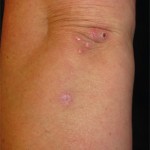Incorrect
C) Stasis dermatitis
Lesions of PPD may, at times, resemble stasis dermatitis, but a few clinical features can help distinguish these entities. Stasis dermatitis is often accompanied by venous insufficiency, and leg edema is frequently the initial symptom. In addition, there is often a diffuse underlying erythema and hyperpigmentation. Varicosities are often apparent in stasis dermatitis, and there may be associated vascular ulcerations or lipodermatosclerosis. Leg elevation and compression therapy are the mainstay of treatment for stasis dermatitis.
Dr. Femia completed a fellowship in dermatology–rheumatology at Brigham and Women’s Hospital in Boston, MA, and is now an assistant professor in the department of dermatology at New York University. She is a diplomat of the American Board of Dermatology.
Dr. Merola is an instructor in the department of dermatology at Harvard Medical School and an instructor in the department of medicine, division of rheumatology at Brigham and Women’s Hospital, both in Boston. He is the assistant program director for the combined medicine–dermatology training program and a diplomat of the American Board of Dermatology and the American Board of Internal Medicine.
